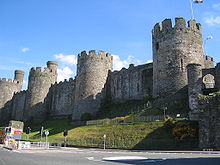John Carter (Roundhead)
Sir John Carter | |
|---|---|
 Conwy Castle, where Carter was Governor, 1646 to 1661 | |
| High Sheriff of Denbighshire | |
| In office November 1664 – November 1665 | |
| Governor of Holyhead | |
| In office May 1660 – April 1661 | |
| Member of Parliament for Denbigh Boroughs | |
| In office April 1660 – December 1660 | |
| Member of Parliament for Denbighshire | |
| In office 1654–1659 | |
| Sheriff of Caernarvonshire | |
| In office February 1650 – November 1650 | |
| Governor, Conwy Castle | |
| In office 1646–1661 | |
| Personal details | |
| Born | c. 1619 Dinton, Buckinghamshire |
| Died | 28 November 1676, aged 54-55 St George, Conwy |
| Nationality | English |
| Spouse | Elizabeth Holland |
| Children | 2 sons, 4 daughters |
| Military service | |
| Rank | Colonel |
| Battles/wars | |
Sir John Carter (c. 1619 – 28 November 1676) was an English soldier, politician and administrator from
Biography
Carter was the second son of Thomas Carter of Denton, Buckinghamshire. He is said to have been apprenticed to a linen-draper, probably in London. During the Civil War he joined the Parliamentary army where he distinguished himself as a Parliamentary officer. As Lieutenant Colonel Carter, he was sent with forces from London to reinforce
In 1654 Carter was admitted a capital burgess of
In 1660, Carter was elected
Carter died at the age of 57 and was buried in St. George's Chapel, Denbigh.[1]
Family
Carter married Elizabeth Holland, daughter and co-heir of David Holland of Kinmel. The country people considered him as a rapacious oppressor and petty tyrant, and claimed that he forced the heiress of Kinmel to marry him. It was joked at the time that he betrayed his former trade by choosing the "best piece of Holland " in the County.[1]
Notes
- ^ The dates in the Williams are inconsistent "9 Oct. 1649-50, and 13 Feb. 1650" usually dates before 25 March are styled 1649-50 in this period (see Old Style and New Style dates), so it may be that he was Sheriff from 13 February 1649 to October 1649 or 1650. All that can be said with certainty from this source is that he was a Sheriff in 1649 and maybe also in 1650.
References
- ^ a b c d e f g Williams, W.R. (1895). The Parliamentary History of the Principality of Wales. p. 74.
- ^ a b c Willis, Browne (1750). Notitia Parliamentaria, Part II: A Series or Lists of the Representatives in the several Parliaments held from the Reformation 1541, to the Restoration 1660 ... London. pp. 229–239.
- ^ Leigh Rayment's Historical List of MPs – Constituencies beginning with "D" (part 1)
- ^ Knights of England
